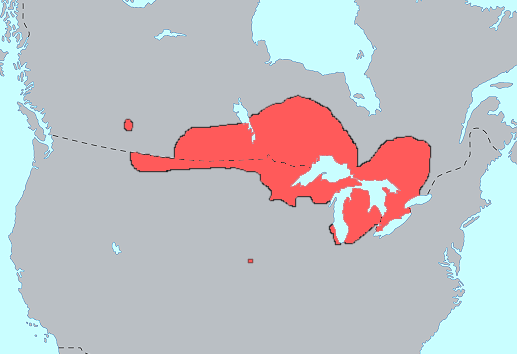


Black Duck's Sacrifice
Makadeshib (Black Duck) was a brave warrior and early chief of the Pembina Band of Ojibwe. He maintained his home camps and hunted at Stump Lake and near Fargo, North Dakota during the early years of the 1800s.
In about 1824, Makadeshib decided to go to war against the Dakota. He sent around tobacco and raised a war party that left Pembina, marching towards Lake Traverse (Sisseton, South Dakota). The march took thirteen days. The war party searched the area around Big Stone Lake and Lake Traverse, but did not find their enemies.
The war party then proceeded west towards Ogema-Wadju (Chief Mountain), a large hill where the Dakota were known to camp. Not finding a village there, the war party soon became disenchanted. Chief Peguis, who was part of the war party, took his men and returned home, but the remaining men who stayed with Makadeshib kept searching until they came upon a village of about 300 Dakota.
That night they attacked, and the fight was a resounding victory for Makadeshib and his troops. However, a few Dakota were able to escape and they made their way to a nearby camp where they roused more warriors who quickly came to press the fight against the Ojibwe.
Out of bullets and tired from the fight, Makadeshib and his men retreated as quickly as they could, but they saw that they would soon be overtaken. Knowing that they would all be slaughtered in the upcoming fight, it was decided that most of the men would keep running, while a small party remained with Makadeshib to fight and secure their escape.
Makadeshib and his stalwart companions calmly took off their clothes down to their breechcloths, folded them into bundles, then they took out their pipes and smoked and prayed to the manitou for pity. Almost 300 Dakota warriors came upon them and the fighting was hand-to-hand. During the short battle, 13 warriors fell, including Makadeshib. One man escaped across the river and was able to sneak away to report the fate of his companions and the brave Makadeshib.
This final battle took place near modern-day Wild Rice, North Dakota, a small town south of Fargo.
During the middle-1800s, a priest named Father Genin - who ministered to the Ojibwe and Dakota - was told about the bravery of Makadeshib and his men. Father Genin went to the location where they fell and ordered the erection of a large, white cross at the spot where they had died.
Years later, as white men finally came to North Dakota after the land was opened up following the 1863 Old Crossing Treaty, many settlers were surprised to see the white cross as they crossed the Red River. Most were unaware that this location was where a mighty warrior and his brave men lost their lives.
Makadeshib is relatively unknown today, but many of his descendants can be found at Cypress Hills and Cowessess Reserve in Canada, and at Turtle Mountain Reservation in North Dakota.
SOURCES:
Henry Rowe Schoolcraft. Indian Tribes of the United States. (1884)
O.G. Libby. Collections of the State Historical Society of North Dakota, Volume 1. (1906)


LEADERSHIP OF THE PEMBINA CHIPPEWA NATION
The Wazhazha Mdewakanton of the O'Jibway Nation is ceremonial. The O'Jibway Nation traces back 2000 years as a collection of Nations who unified and worked collectively to establish trade, and family unity, among the Haudenosaunee, Anishinaabemowin, and Algonquin descendants of the Great Lakes. Ojibwa, also spelled Ojibwe or Ojibway, also called Chippewa, self-name Anishinaabe, Algonquian-speaking North American Indian tribe who lived in what are now Ontario and Manitoba, Can., and Minnesota and North Dakota, U.S., from Lake Huron westward onto the Plains. These matrilineal-patrilineal lines merge with one family.
26. Private *Red Bear Band Leadership
25. Ogimaa Ma'Lingaan *Red Bear Band Leadership
24. Elmer Patrice Brunelle *Red Bear Band Leadership
23. Patrice "Petite" Francis Brunelle *Red Bear Band Leadership
22. A branch deviates to Little Shell VII Louis Delorme of Little Shell Pembina Chippewa, to Private of Little Shell Pembina Chippewa Tribe.
22. Chief Ayabewaywetung, Ase Ance, Little Shell III (1872-1903) --->Turtle Mountain Branch Separation and leadership went to Chief Joseph Kaishpa "The Elevated One" Gourneau
21. J.B. Brunelle --->Pembina Chippewa Tribe Separation and leadership went to Patrice "Petite" Francis Brunelle *Red Bear Band Leadership
20. Red Bear II *Red Bear Band Leadership
19. Chief Weesh-e-damo, Aisaince III, Little Shell II (1813-1872)
18. Joseph Montrielle, Chief of Pembina Chippewa *Red Bear Band Leadership
17. Chief Makadeshib Black Duck (1811-1813)
17. Joseph Lenau, Tabasnawa Little Shell II (1790-1804)
16. Red Bear Miscomaquah *Red Bear Band Leadership
16. Chief Little Shell I, Standing Firm
15. Chief Gay Tay Menomin Old Wild Rice
14. Chief Kaŋgidaŋ Mdokečiŋhaŋ, Little Crow I
13. Chief Delonaise Atetaŋkawamduška Wáȟpe Šá
12. Waubojeeg
10. Chief Ka-che-ne-zuh-yauk Kahdewahbeday Broken Tooth
9. https://www.geni.com/people/Chief-Ojibwaince-Bajasswa-Biauswah-II/6000000082327519872'''
6. Wajawadajkoa
5. Wajki Weshki
3. Mitiguakosh
1. Chief Gijigossekot Great Thunderbird
O'Jibway Nation Ogimaakwe: Machequayaince daughter of Wazhazha Mdewakanton Dakota Grand Chief Chief Delonaise Atetaŋkawamduška Wáȟpe Šá; sister of Red Bear Miscomaquah, son of Bajasswa
| 1790 |
1790
|
||
| 1815 |
1815
|
||
| 1824 |
1824
|
||
|
1824
Age 34
|
|||
| 1825 |
1825
|
Red River Settlement
|
|
| 1827 |
1827
|